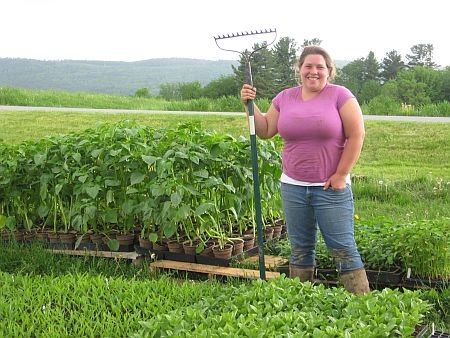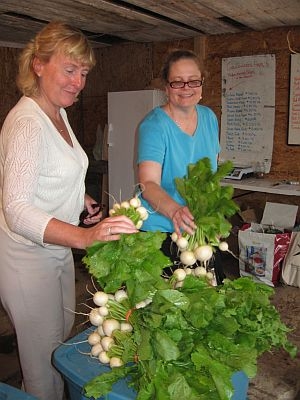
(Host) The growing popularity of Rutland’s farmers’ market is driving up demand for local food in the region.
As VPR’s Nina Keck reports, that’s led to a surge in the number of farms selling directly to customers.
(Keck) Back in early May, Margaret Evans lifted the muddy edges of one of several temporary plastic greenhouses at her farm in Pittsford.
(Evans) "Underneath them we have beets and carrots – which we planted in March when there was still snow on the ground out here so we would have beets and carrots earlier for our CSA."
(Keck) Five weeks later, Evans and her partner Kevin Brown were handing customers their first bushels of leafy greens.
Groundworks Farm is one of a growing number of CSAs – that stands for community supported agriculture. It’s a business model in which farmers are paid a subscription fee up front – usually in late winter or early spring – for a set amount of produce or meat throughout the year. Margaret Evans says selling shares helped lessen their risk.
(Evans) "We saw that this was a way that not only could we do something we love, but we could make a business out of it. And a lot of people have it in their heads that they can’t really make a living farming and we believe we can. And the CSA model is a way that we can do it on a smaller scale, too."
(Keck) According to the Northeast Organic Farming Association, the number of CSAs in Vermont grew from 28 in 2000 to nearly 100 in 2010.
(Kelly) "I can think of about 15 small vegetable farms that have started up in the last two years in our county."
(Keck) Tara Kelly is executive director of the Rutland Area Farm and Food Link, or RAFFL. While Kelly says parts of Vermont, like Addison County, have been ahead of the curve with CSAs, other regions of the state, like Rutland are catching up.
(Kelly) "Just in the last couple years we’ve had an explosion of newer farmers in our area that are responding to the fact that there’s an increased number of people interested in local food."
 (Keck) People like Nancy Gondella of Wallingford, a client of Groundworks Farm.
(Keck) People like Nancy Gondella of Wallingford, a client of Groundworks Farm.
(Gondella) "I think it’s nice to support local businesses and also to have fresh produce, locally grown, so I thought I’d give it a try and just based on the things that I got today it seems pretty cool."
(Keck) At the Hathaway Farm, in Rutland Town, they’ve been raising beef for three generations. But BJ Hathaway says they didn’t offer a beef CSA until last year when more customers began asking for one. Hathaway says it’s been good for business.
(Hathaway) "I mean it’s 24 months from the time these little guys are born to when that beef is available for sale. So it’s not like chickens that you raise in 6 weeks or pigs that are ready in 9 months. It’s a long term deal here and to manage that whole chain a known set of sales has value to me and in that way I can pass along a little bit of a price advantage to the consumer."
(Keck) Vermont leads the nation when it comes to per capita direct to consumer farm sales, which includes farmer’s markets, farm stands and CSAs. Those sales totaled nearly $30 million in Vermont in 2007. But at $37 per person per year, it’s still only 2.5 percent of the total food purchases by Vermonters. So farm advocates say there’s a lot of room for growth.
For VPR News, I’m Nina Keck in Rutland.